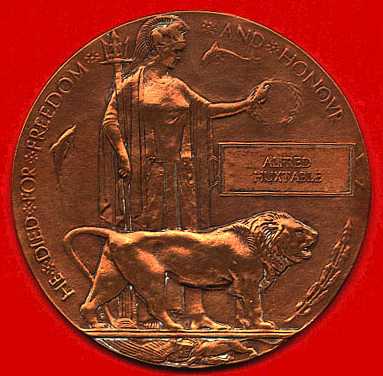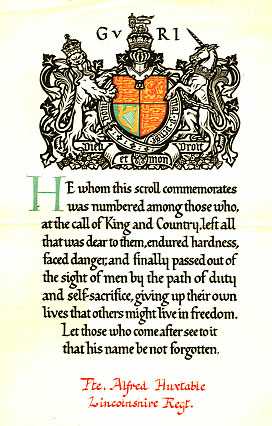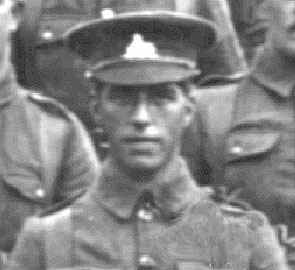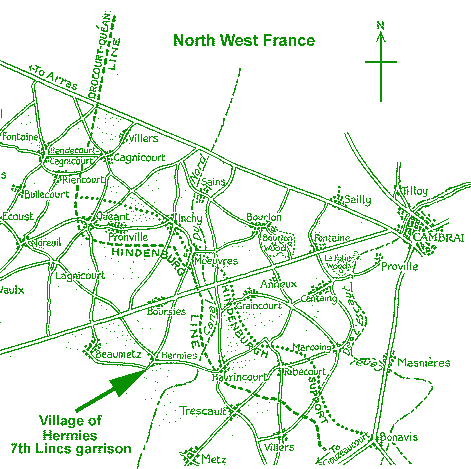British Commonwealth Memorial Plaques
 | First World War Memorial Plaque Diameter 4.75 inches - Cast in Bronze |
Images and text contributed by
ø James F. O'Sullivan
e-mail: finbarr@netspace.net.au
|
British Commonwealth Memorial Plaques Mid way through the First World War it was announced that next of kin of all soldiers from within the British Commonwealth, whose deaths were attributable to the War would receive a memorial plaque and scroll. In 1917 a competition was announced to obtain a suitable design and 800 entries were eventually received. The winner, Mr. E. Carter Preston of Liverpool England was chosen in 1918. He was awarded a prize of 250 pounds sterling currency. A Mr. Manning Pike directed manufacture of the memorial plaques at the 'Memorial Plaque Factory' set up at Acton London England. Some later plaques were made at Woolwich Arsenal London. Each plaque had the name of the soldier commemorated, individually embossed (although later some were engraved) as part of the design. The soldiers full name was given without any indication of rank or honours to show equality of sacrifice of all those who lost their lives. A scroll seven inches wide by eleven inches in height was designed to accompany the plaque and was of thick paper bearing the following message - 'He whom this scroll commemorates was numbered among those who, at the call of King and Country, left all that was dear to them, endured hardness, faced danger, and finally passed out of the sight of men by the path of duty and self-sacrifice, giving up their own lives that others might live in freedom. Let those who come after see to it that his name is not forgotten.'
The plaques were enclosed in an envelope measuring five inches square, the flap of the envelope was embossed with the royal coat of arms. This in turn was enclosed in a thick cardboard container for dispatch to the next of kin, included was a small 'with compliments' slip. Over the years, many plaques have now found a place with collectors of military memorabilia. This plaque, scroll and photographs below came into my possession some years ago at a military memorabilia sell/swap meet. Private Alfred John Huxtable
The above photograph of Private Alfred John Huxtable was probably taken in England The 9th Lincolns was a Training Reserve Battalion which never left the country. Pte A.J. Huxtable was killed in action fighting with the 7th Lincs at Arras northern France. He has no known grave, however he is commemorated on the Arras Memorial. The official history for the day of 23-Mar-1918 describes the events as follows: "The first serious fighting of the day was a heavy attack beginning, after a bombardment, at 9.30am against Hermies (a French village south, south west of Arras, garrisoned by the 7th Lincs of the 17th Division). Fortunately, the enemy shells fell on the village itself, whilst the defenders lay well in front of it, commanding all the ground over which the Germans must attack. The enemy advance....exposed to a steady field gun barrage and heavy machine gun fire, was slow. After being enfiladed....by LXXIX Brigade RFA (Royal Field Artillery) firing shrapnel, the infantry helping to bring up ammunition ....the Germans finally came to a standstill at 1pm about quarter of a mile away (from 7th Lincs)....at 5pm the assault (by the Germans) was abandoned. The German losses were heavy., in fact the dead lay in piles before the wire....A surprise attempt made after dark also failed...."
Biographical details from the register of the Arras Memorial - Commonwealth War Graves Commission:
The contributor, J.F. O'Sullivan, expresses his special thanks to Colin Haynes and Hal Giblin, members of the 'Western Front Association', for the biographical update on Pte A.J. Huxtable and the action report for the day. |




